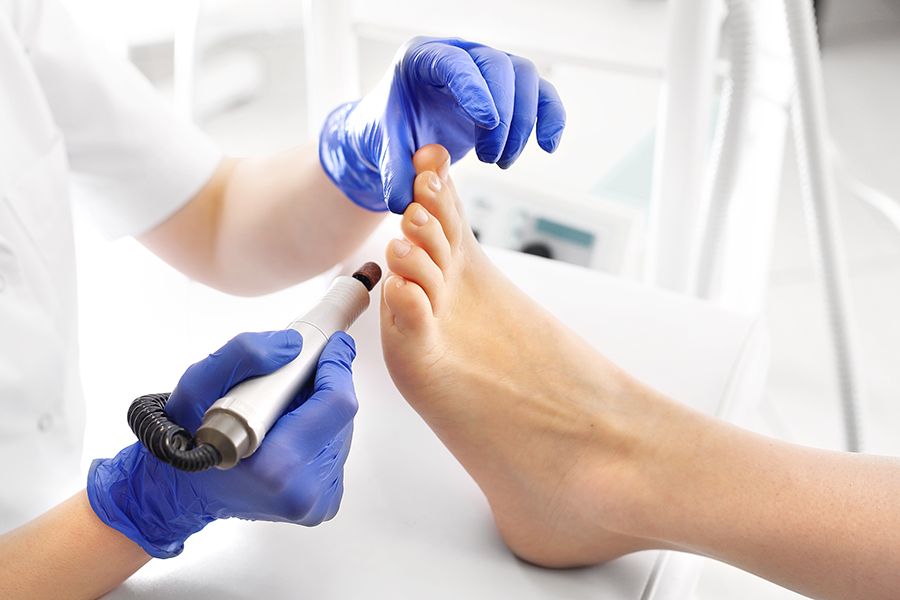What Are Foot Corns and How To Treat Them?

What are Foot Corns?
Foot corns are simply areas of skin that have become thicker than the surrounding skin due to friction and use. Typically, the pressure from this causes the skin to thicken; this may produce extreme pain, affecting the deeper layers of the skin. Commonly found on the feet, corns are circular or cone-shaped. Corns can actually serve a positive purpose – to protect the underlying skin. They most commonly form on the sides or tops of the toes or the balls of the feet.
Different types of corns
Hard Corns – Hard corns are generally caused by poorly fitted shoes and may develop on the top of the toes.
Soft Corns – Corns that affect the area in between the toes are referred to as soft corns, and moisture from the toes may be the underlying reason for this condition.
Difference Between Corns and Calluses
Corns are often confused with a callus, but there is a difference between them. Corns can be raised bumps that are painful to the touch. They consist of a rough, thick area of skin that may be dry or waxy. Corns tend to be surrounded by skin that is inflamed, and are usually much smaller than calluses.
What Causes Corns?
The most common reason they form is poorly fitting shoes (during running or walking) and/or arthritis. They develop where there are areas of pressure or friction, such as on the little toe when it rubs up against shoes, or on the ball of your foot.
How to Treat Corns
Corns can eventually become annoying and unappealing. Treatment of corns involves removing the dead skin that has built up in the specific area of the foot. Consequently, foot care specialists recommend you do the following to treat this common skin condition if it becomes annoying:
- Make Sure Your Shoes Fit Properly: Poorly fitting shoes, either too loose or too tight, can cause excess friction and pressure on the toes and other areas of the foot. Therefore, one way to prevent corns from developing, to begin with, is wearing properly fitting shoes. If you already have corns, it’s important to make the changes in your footwear as soon as possible to get rid of the corns and/or prevent them from coming back.
- Use a Pumice Stone: One way to remove the rough skin associated with corns is through the use of a pumice stone. The process will be easier if you immerse the pumice stone in warm water before scrubbing. Also, avoid a sideways motion and instead move the pumice stone in a circular motion to remove dead skin.
- Apply Lotion Regularly: Find a good moisturizing lotion that contains urea, ammonium lactate or salicylic acid. Apply this lotion on a daily basis. Over time, doing this will soften your calluses and/or corns.
- Try Some Padding: Wear padding to protect your corns from additional irritation. Purchase an adhesive pad in a donut-shape, which you can find at any drugstore. By using these adhesive pads, you will prevent your corn from coming into contact with your shoe and becoming more irritated.
- Use Salicylic Acid Medication: The acid works by dissolving keratin, which is the protein that makes up the majority of corns. You can purchase salicylic acid over-the-counter in products such as wart removers. It comes in a variety of forms such as medicated pads, drops, or creams. However, people who are diabetic should not use salicylic acid, but should instead consult their doctor immediately. According to the product directions, applying the medication directly onto the corn will treat it. The top layer of the corn will begin to turn white after use. When that occurs, the layers of skin can then be peeled away, making the corn smaller.
- Make Sure Your Toenails Are Properly Trimmed: Corns can form when toenails are not properly maintained and become too long, causing the toe to push against the shoe, resulting in excessive pressure. To remedy this issue, ensure your toenails are trimmed on a regular basis. If you are unable to do this task yourself, consider visiting a professional to have the service completed.
- Use a Home Remedy: There are various home remedies you can try to remove problematic corns. The following are a few of the most notable:
- White Vinegar: White vinegar is a tried and true method that has been used effectively to remove corns. Vinegar’s high level of natural acidity softens the problem skin. To use white vinegar as a treatment for corns, mix ¾ water and ¼ vinegar and dab on the affected area. Once applied, cover the area with a bandage. Keep the bandage on for 8 to 10 hours, then remove and clean the area.
- Lemon: The acid in lemon is another way to soften the hardened skin affected by a corn. Squeeze the lemon juice onto the affected area around three times daily until the skin is softened.
- DO NOT USE RAZORS TO SHAVE CORNS: Shaving off corns with razors or other pedicure equipment is never a good idea. This can lead to infection. If your corn gets infected, and is not treated immediately, a visit to the doctor will be necessary.
- Foot Surgery: Surgery is rarely used to treat corns, but does occur on occasion. Surgery actually deals with the underlying issue that causes corns. During surgery, the bone is shaved and any abnormalities are corrected, thus reducing the amount of friction that occurs during walking.
- See a Podiatrist: Sometimes, a problem corn needs the help of a professional, i.e. a podiatrist, to completely irradiate. Professionals in foot care like those at Red Mountain Footcare are well equipped to treat annoying and sometimes painful conditions like corns.
How to Prevent Corns
To prevent corns, the first step is reducing friction. There are many ways to limit friction and get rid of painful corns, such as:
- Well-fitting socks
- Comfortable shoes that are not tight around your foot
- Cushioned insoles in your shoes
- Orthotic inserts fitted by a podiatrist
If you have any questions, please feel free to contact our office located in Mesa, AZ. We offer the newest diagnostic and treatment technologies for all your foot and ankle needs.
